| Back Number | No.09 2005/02/16 | |||
| News | Art Program Exhibition, “DIVERSE WAYS OF HAPPINESS ” |  |
||
| Pavilions : Earth Tower (Nagoya City) | ||||
| Interview | Lisa Guillermin Gable (U.S.A.) U.S. Commissioner General, EXPO 2005 Aichi, Japan |
|||
| Column | Aichi International Campaign for Hometown Interchange and Hospitality(AICHI Hospitality) | |||
![]()
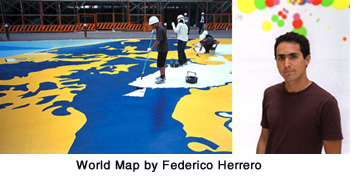 The Japan Association for the 2005 World Exposition announced the details regarding the works to be shown as part of the Art Program, a display of new works created by artists from around the world at various sites within EXPO 2005 Aichi, Japan’s Nagakute Area.
The Japan Association for the 2005 World Exposition announced the details regarding the works to be shown as part of the Art Program, a display of new works created by artists from around the world at various sites within EXPO 2005 Aichi, Japan’s Nagakute Area.The theme of the Art Program is “DIVERSE WAYS OF HAPPINESS.” What kind of a form does happiness take in the age that we live in faced by many difficult issues? The aim of the Art Program is to have young and upcoming artists active around the world give a free and subjective response to this question through art. Seven artists from Japan and abroad, who were selected by the Art Program curators with the assistance of international organizations and cultural agencies around the globe, will be exhibiting their works as part of this program. All of the artists were born in or since 1970, the year in which the Japan World Exposition Expo’70 was held in Osaka. The artists, who grew up during a period when existing values and ethics swayed greatly, will make an artistic expression of “happiness” as seen through their eyes, and their seven large-scale works will be installed outdoors with the presence of each artist at the six Global Commons and Hotei-Pond in the Japan Zone. The title of the piece by Federico Herrero of Costa Rica is “World Map.” Four colorful world maps of differing sizes, shapes and hues have been depicted on the floor of two ponds at Global Common 6, home to the pavilions of Oceania and Southeast Asia. The world maps raise the issues faced by the world today through their expression of the relationship between water and countries, the preciousness of water or the state of the Earth as it is today, etc. It will include a bright red map that represents the accumulation of issues in the world, and a map of the world that show land masses that have shrunk in size due to rises in sea levels caused by global warming. It is the artist’s hope that the four world maps depicted on the floor of the shallow pools will evoke a reaction in the minds of the children who walk and play in the ponds and create a sense of awareness. Student volunteers from Aichi Prefecture assisted Herrero during his work on the piece last November at the EXPO 2005 venue. South Korean artist Han Zin-Su’s piece to be exhibited at Global Common 3 which features the pavilions of Europe is “THE TREE OF A PUBLIC GARDEN.” Approximately 5,000 paper dolls, uniform in shape and size and representing human beings, hang from an existing 20-meter high light fixture. The heaven-bound mass of dolls expresses the difficulty and importance of respecting individuals who are indistinguishable from the group. |
 Tomoko Sawada of Japan will be exhibiting 12 giant portraits using the façade of the Africa Joint Pavilion at Global Common 5. The title of her work is “FACE.” Befitting the stage of a world exposition where people of different ethnic backgrounds and language will be gathering, she assumes the guise of people of 12 different ethnicities in her self-portrait photographs. The artist calls upon people to share the joy of being born into this world as a human being, regardless of country or ethnic group, and the preciousness of our loving one another.
Tomoko Sawada of Japan will be exhibiting 12 giant portraits using the façade of the Africa Joint Pavilion at Global Common 5. The title of her work is “FACE.” Befitting the stage of a world exposition where people of different ethnic backgrounds and language will be gathering, she assumes the guise of people of 12 different ethnicities in her self-portrait photographs. The artist calls upon people to share the joy of being born into this world as a human being, regardless of country or ethnic group, and the preciousness of our loving one another.Other artists exhibiting works are Ivana Falconi (Switzerland), Tea Mäkipää (Finland), Risa Sato (Japan) and Kohei Nawa (Japan). For details regarding the artists and their works, please visit http://www.expo2005press.jp/ml/en/09/art_en.html |
![]()
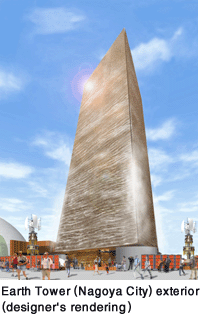 One of the tallest pavilions at EXPO 2005 Aichi, Japan, “Earth Tower” is an eye-catching structure located at around the center of the Nagakute Area. It is presented by Nagoya City, the capital of Aichi Prefecture.
One of the tallest pavilions at EXPO 2005 Aichi, Japan, “Earth Tower” is an eye-catching structure located at around the center of the Nagakute Area. It is presented by Nagoya City, the capital of Aichi Prefecture.Visitors to Earth Tower will be able to experience the fortuitous performances staged by nature through light, wind and water. The tower itself is the world’s largest kaleidoscope. It rises 47 meters in height and is in the shape of a triangular pyramid with its tip cut at angle. The slanted glass ceiling forms a triangle with two equal sides. Its surface faces due south to enable as much sunlight as possible to shine into the pavilion. The rays pass through three disks containing tinted oil, then hit mirrors on the wall which create kaleidoscopic giant spherical images approximately 40 meters in diameter. Visitors look up from the second floor viewing space and see a fantastical and mystical world created by the sun’s rays. Ear-pleasing tones resonate around the tower. They are the original melodies created by the wind through an array of Sound Forms, a musical instrument that has it own unique musical scale. There are three handmade Sound Forms in place. Each is roughly 8 meters high and has a windmill on top that plays a xylophone/metallophone-like musical instrument below. A different melodious arrangement is created depending on the strength of the winds that change by season and time. An infinite number of harmonies come forth from the Sound Forms by fancy of the wind to soothe the ears of visitors. |
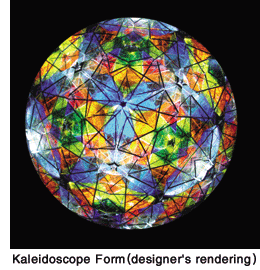 An Aqua-wall formed by water streaming down from the tower’s peak gently envelops the tower. Bumps on the surface of the exterior walls make the water jump and skip to create a variety of random patterns.
An Aqua-wall formed by water streaming down from the tower’s peak gently envelops the tower. Bumps on the surface of the exterior walls make the water jump and skip to create a variety of random patterns.When dusk falls, lanterns that surround the Earth Tower are lit. About two meters high, the lanterns are encased in roughly 2,000 paper cut-out designs created by citizens. The shimmering light of the lanterns is a beautiful addition to the mood of the tower that invites visitors into an ethereal world. |
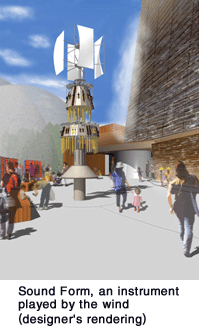 Fumiya Fujii, a famous Japanese musician and computer graphics artist, is the general producer of this pavilion. He says that he wanted to make Earth Tower a pavilion that evokes a sense of comfort and kindness within the heart of visitors.
Fumiya Fujii, a famous Japanese musician and computer graphics artist, is the general producer of this pavilion. He says that he wanted to make Earth Tower a pavilion that evokes a sense of comfort and kindness within the heart of visitors.We look forward to visitors experiencing the healing powers of nature through the performance of light (the kaleidoscope), wind (Sound Form), and water (Aqua-wall) combined with the tenderness of people (paper cut-out lanterns). |
![]()
![]()
 |
|
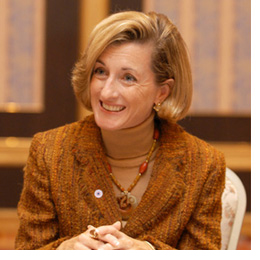 The U.S. Pavilion at EXPO 2005 Aichi, Japan, presents a unique view of America’s awe for the world of nature through the Franklin Spirit. With our host Benjamin Franklin, this theatrical presentation reviews 300 years of scientific research and exploration of Nature’s abundance and power revealing an enormous amount about the national character and thinking of the United States today.
The U.S. Pavilion at EXPO 2005 Aichi, Japan, presents a unique view of America’s awe for the world of nature through the Franklin Spirit. With our host Benjamin Franklin, this theatrical presentation reviews 300 years of scientific research and exploration of Nature’s abundance and power revealing an enormous amount about the national character and thinking of the United States today.This sets the stage for the visitor experience of our American Journey Gallery. Here the visitor sees our national courage and enterprise, from our first flight by the Wright Brothers, to today’s exploration of Mars and Saturn, ongoing as we speak. The Gallery also includes a look in the future of automotive transportation as envisioned by General Motors and its hydrogen fuel cell powered concept vehicle, AUTOnomy. Befitting the first world exposition of the 21st century, throughout the EXPO 2005 venue, visitors will be presented with new technological solutions that are beneficial to humankind. EXPO 2005 will allow people to discover various cutting-edge technologies that may become a doorway to new possibilities for humankind. The government and people of Japan are gracious and experienced Expo hosts, having organized such successful international events of importance as Osaka Expo ’70 and Tsukuba Expo ’85. That experience is being drawn upon to the fullest in the unprecedented level of planning and preparation for all aspects of EXPO 2005. EXPO 2005 is being defined by a profound respect for the preservation of the natural growth and environment of its site, from the modular building system used for environmentally sensitive accommodation to the longer-term plan to restore the site. These are unusual and admirable aspects of the planning and execution of this Exposition and will no doubt serve as an extraordinary example for future Expos. |
|
![]()
 |
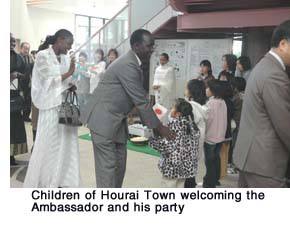 There are a total of 122 countries that are officially participating in EXPO 2005 Aichi, Japan. Reassuring backup for the people gathering in Aichi Prefecture from around the world for EXPO 2005 will be present. They are the citizens of the prefecture’s municipalities (cities, towns and villages).
There are a total of 122 countries that are officially participating in EXPO 2005 Aichi, Japan. Reassuring backup for the people gathering in Aichi Prefecture from around the world for EXPO 2005 will be present. They are the citizens of the prefecture’s municipalities (cities, towns and villages).This is the Aichi International Campaign for Hometown Interchange and Hospitality (AICHI Hospitality) that will be going on during EXPO 2005. In this project, 86 municipalities of Aichi Prefecture (excluding Nagoya City) will partner with official participant countries and become a “home city/town.” The aim is to deepen international exchange by having visitors from participant countries feel at home as the people of the host municipality warmly welcome visitors from their partner country, become boosters of their events, and so on. With less than two months left before the opening of EXPO 2005, the AICHI Hospitality project is picking up much steam. The pre-EXPO 2005 undertakings are focused on those meant to enhance understanding of their partner countries, and international exchange at the grass-roots level is also spreading. Hourai Town, located in eastern Aichi Prefecture, is an area surrounded by beautiful nature and mountains. On Sunday, January 30, Japanese children waving the flags of Ethiopia and Japan, and the town’s brass band, welcomed the arrival of the Ambassador of the Federal Democratic Republic of Ethiopia and his party at the town’s central assembly hall. The day was Hourai Ethiopia Day. This was the first time for almost all of the 300 town residents gathered to meet people from Ethiopia. The walls of the assembly hall were decorated with pictures drawn by Ethiopian children. Products from Ethiopia were also on display. Town residents had a chance to try Ethiopian dishes, and they also experienced a coffee ceremony from the country where coffee originated. As the program advanced, Ethiopia became an increasingly familiar country for Hourai Town residents. After the event, one local resident said, “It was very good because it gave me a good understanding of Ethiopia. I will support Ethiopia during EXPO 2005, and I hope that I will have various opportunities to interact with Ethiopian people even after the EXPO is over.” |
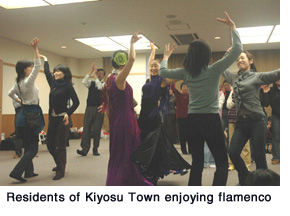 That same day, 200 people gathered for an event at Kiyosu Town located in the vicinity of Nagoya City, Aichi’s prefectural capital. The occasion was a international exchange get-together organized by the Kiyosu International Association. Mr. Javier Echeveste, Deputy Coordination Manager of the Spanish Pavilion, participated in the event. Kiyosu Town became a sister city of Jerez de la Frontera, a city in southwestern Spain, in 1994, so there has been strong interest in Spain by the community even before the EXPO. Many people are learning Spanish through courses organized by the International Association. On the day of the event, participants learned more about Spain as well as Spanish through quizzes and games. They also had a chance to taste Spanish cuisine. The get-together ended in high spirits with all of the participants dancing the Flamenco. Many participants were heard saying after the event that they had had a wonderful time and that it made them want to get to know even more about Spain and to visit Spain. They said they will be sure to visit the Spain Pavilion at EXPO 2005.
That same day, 200 people gathered for an event at Kiyosu Town located in the vicinity of Nagoya City, Aichi’s prefectural capital. The occasion was a international exchange get-together organized by the Kiyosu International Association. Mr. Javier Echeveste, Deputy Coordination Manager of the Spanish Pavilion, participated in the event. Kiyosu Town became a sister city of Jerez de la Frontera, a city in southwestern Spain, in 1994, so there has been strong interest in Spain by the community even before the EXPO. Many people are learning Spanish through courses organized by the International Association. On the day of the event, participants learned more about Spain as well as Spanish through quizzes and games. They also had a chance to taste Spanish cuisine. The get-together ended in high spirits with all of the participants dancing the Flamenco. Many participants were heard saying after the event that they had had a wonderful time and that it made them want to get to know even more about Spain and to visit Spain. They said they will be sure to visit the Spain Pavilion at EXPO 2005.These are just two examples of the numerous international exchange activities that are taking place throughout Aichi Prefecture. While EXPO 2005 will have National Days that will provide an opportunity for participating countries to introduce their culture and society, the residents of the municipalities participating in the AICHI Hospitality project will surely play a role in helping to boost the mood of these special events. The Grand Intercultural Symphony, one of the motifs of EXPO 2005 Aichi, Japan has already begun. Everyone is looking forward to the opening of this world exposition. |
| EXPO 2005 AICHI, JAPAN Newsletter | |
| To read past issues:Back Number | |
| Editor/Publisher: Japan Association for
the 2005 World Exposition Head Office: 1533-1 Ibaragabasama, Nagakute-cho Aichi 480-1101 Japan Nagoya Office: Nagoya Daiya II Bldg 4F, 3-15-1 Meieki Nakamura-ku, Nagoya, Aichi 450-0002 Japan Tokyo Office: Iino Bldg 8F, 2-1-1 Uchisaiwai-cho Chiyoda-ku, Tokyo 100-0011 Japan |
 |
© Japan Association for the 2005 World Exposition
